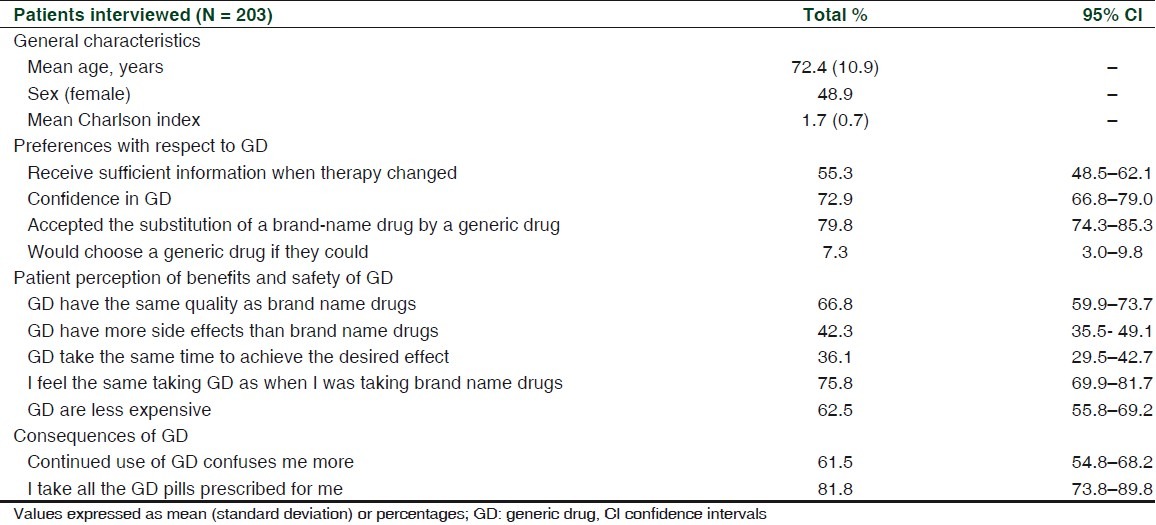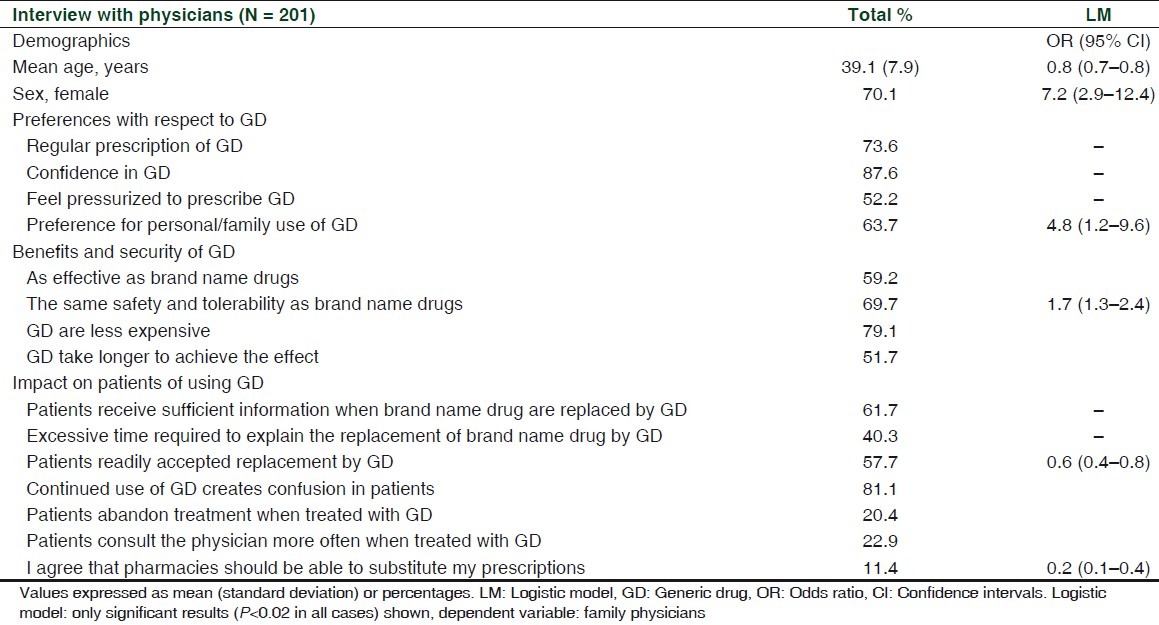Sir,
Generic drugs (GD) have the same therapeutic effects, safety and quality and bioequivalence as their original brand name counterparts.[1] Some authors suggest that substitution by GD would be facilitated by educational measures, clear and independent patient information and encouragement of their use in specialized care.[2–5] The objective of this study was to evaluate the opinions of physicians (primary care and specialist) and patients on the regular use of GD.
We designed a cross-sectional study using structured interviews. The study population consisted of patients assigned to six primary healthcare centers and a hospital center. The population attended is mainly urban, with a lower-middle socioeconomic level and predominantly engaged in industry, commerce, and services. Policies on staffing, training levels, organization, and services offered are representative of centers in Catalonia. Inclusion criteria: the patients treated with brand name amlodipine and simvastatin which were substituted by a GD between 1/1/2006 and 30/6/2009 who complied with the following characteristics: (a) age ≥ 40 years, (b) patients diagnosed with hypertension or hyperlipidemia, and (c) in receipt of substitute GD for ≥1 year. We selected patients treated for hypertension (amlodipine) and hyperlipidemia (simvastatin) to be high prevalence chronic conditions. The Charlson index was used to estimate comorbidity. We studied the number of chronic comorbidities according to the criteria of the WONCA. Physicians’ and patients’ opinions were collected through structured interviews. Physicians were selected using nonprobabilistic consecutive sampling of all prescribing physicians (N = 472), and selected physicians were contacted during clinical sessions in each service (primary care and specialist). In patients, the sample size was calculated assuming an expected acceptance of GD of 80% with a precision of 5% (N = 201 subjects). For the development of interviews with physicians (family medicine and specialists), the sample size was calculated assuming a prevalence of GD of 10% with a precision of 5% (N = 98 subjects for group). Interviews were conducted in October and November 2009 and lasted about 5–10min. People with physical or mental limitations that impeded their response to the telephone interview, people with incorrect telephone numbers or those not located after three calls on different days at different times, and people who refused to participate were considered as missing. Stepwise logistic regression analysis was carried out with the variable, family physicians’ opinions, as the dependent variable (Wald statistic). In the logistic model, the following were included as independent variables: Doctor, gender and age. The 95% confidence intervals (CI) were calculated.
Of the 14,616 hypertensive patients and 20,366 patients with dyslipidemia registered in the centers, 1252 met the inclusion/exclusion criteria and were randomly sampled: 620 (49.5%) treated with amlodipine and 632 (50.5%) with simvastatin. Of these, 208 patients were randomly selected. Five patients refused to be interviewed and therefore 203 interviews were finally carried out. Of the 203 patients interviewed (amlodipine: N = 96, 47.3%; simvastatin: N = 107, 52.7%), 55.3% stated that they had received sufficient information, 66.8% that GD have the same quality, 61.5% that they were confused by differences in product presentation, and 18.2% that they had not complied with treatment. Of the 201 physicians interviewed (primary care, N = 98; specialist, N = 103), 73.6% regularly prescribe GD, 59.2% believe that GD are equally effective as brand name drugs and 57.7% believe they take longer to achieve the desired effects. In results, differences exist between the views of family physicians and specialists. In the logistic regression analysis, family physicians had a greater preference for the personal/family use of GD (OR = 4.8, 95% CI 1.2–9.6) and greater acceptance of their safety and tolerability profile (OR = 1.7, 95% CI 1.3–2.4, P <0.02) but fewer thought pharmacies should be able to replace brand name drugs with GD (OR = 0.2, 95% CI 0.1–0.4). Tables 1 (patients) and 2 (physicians) describe the general characteristics of the series, the associated co-morbidities, and interviews.
Table 1.
General characteristics: results of interviews with patients

Table 2.
General characteristics: results of interviews with physicians

Patients and physicians (primary care and specialist) gave a low score to the information received on the substitution of a brand name drug by a GD, similar to the results of other studies,[2–5] suggesting the need for greater health education. Possible study limitations include the fact that the results are only applicable to our organizational model and physicians, and cannot be easily generalized to other institutions. One limitation of the study may be due to recall bias, due to the time elapsed between the period of replacement of drug and the realization of the interview. However, all patients were taking a drug at the moment of interview. In conclusion, although the use of GD is vital in order to reduce pharmaceutical expenditure, patients who received substitute generic brands of amlodipine and simvastatin and the physicians who prescribed them both evidenced a worrying lack of information on their use.
ACKNOWLEDGMENT
The authors would like to thank A J. Rejas for methodological assistance.
REFERENCES
- 1.Palma Morgado D, Domínguez Camacho JC. Generic drugs, a matter of bioequivalence. Farm Hosp. 2007;31:73–4. doi: 10.1016/s1130-6343(07)75716-1. [DOI] [PubMed] [Google Scholar]
- 2.Ruiz-Rico T, Moreno Villar A, Nacle López I. Algunas reflexiones sobre los medicamentos genéricos. Farm Hosp. 2008;32:182–3. doi: 10.1016/s1130-6343(08)72838-1. [DOI] [PubMed] [Google Scholar]
- 3.Honrubia Alujer F, Carbajal de Lara JA, Cebrián Picazo C, Cuéllar Bolas B, Silvestre Molina P, Merino Campos P, et al. Grupo de Investigación del COF Albacete. Acceptance of replacement by generic medicines at community pharmacies. Aten Primaria. 2007;39:81–5. doi: 10.1157/13098675. [DOI] [PMC free article] [PubMed] [Google Scholar]
- 4.Sagardui-Villamor JK, Rodríguez-Labajo M Lacalle, Casado-Buendía S. Sustitución de medicamentos de marca por genéricos en atención primaria. Factores asociados al rechazo. Aten Primaria. 2005;36:489–93. doi: 10.1016/S0212-6567(05)70550-3. [DOI] [PMC free article] [PubMed] [Google Scholar]
- 5.Blasco Oliete M, Torres Bouza C, Medina Bustillo B, Sanz Cuesta T, Neira León M. Opinión de los usuarios de atención primaria sobre los medicamentos genéricos y el coste de la medicación. Aten Primaria. 2003;31:170–7. doi: 10.1016/S0212-6567(03)70678-7. [DOI] [PMC free article] [PubMed] [Google Scholar]


